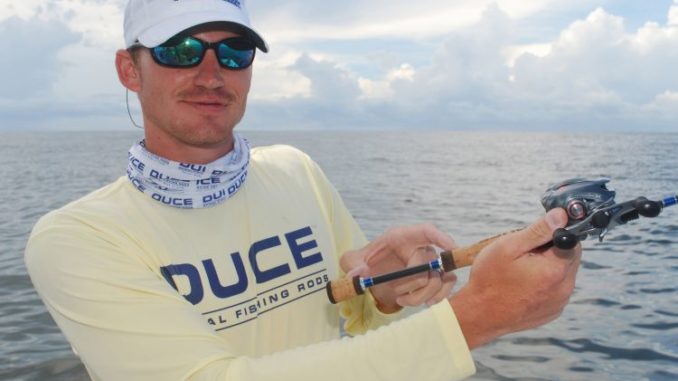
At the end of the day, Cade Eskridge asked the men to give him feedback on the Duce rods they had tested.
After all, that was part of what this whole gig was about.
Never bashful, Lane LeMaire (who had been using a 6-foot, 8-inch, medium-heavy, moderate-fast Wildcard Series rod) opened up first.
“It’s a little stiffer than I am used to, but I was getting really good distance out of it,” LeMaire said. “I am more used to a faster tip, but it is a good live-bait rod.”
Eskridge didn’t disagree.
“To me it’s a better redfish rod than a trout rod, but I wanted to get your opinion,” he said. “The moderate-fast action loads the blank gradually, allowing popping corks to be cast longer and more effectively.
“It’s called ‘utility’ because it is a good all-purpose fishing rod. A lot of bass guys like it because it’s good for shallow-water cranking and topwaters.”
Casey McLaurin, who had been using a 6-foot, 8-inch medium-light weight, moderate-fast Saltwater Series rod was up next.
“The rod I was using is perfect for people who like to fish trout,” McLaurin said. “I’ve used it before with plastics and topwaters. It’s lightweight, so it’s not tiring.
“The micro guides and the spiral wrap technology allow for good casting distance.”
Spiral-wrapping is the placement of the line guides starting with the first one from the reel on top of the rod and each one successive one being set farther to the side until the tip guide is on the bottom of the rod.
Eskridge said there was a reason for the size and positioning of the guides.
“The micro guides reduce line slap and increase casting distance,” Eskridge said. “The spiral-wrapping reduces twisting torque when the rod is loaded with a fish.
“Although all of the rods here have moderate-fast tips, this one bends more because it is medium-light weight. It has a split-grip reel seat, which is where the angler’s forefinger goes, increasing sensitivity.”
Shane Zeringue had been using a 7-foot, medium-weight, moderate-fast trout/light redfish rod.
“I have the advantage in having used this rod for several months,” Zeringue said. “I like its light weight. When you fish all day every weekend, a rod that weighs a lot wears on you a lot. I can feel a lot with the rod.
“These also don’t break as often as other rods. We fish in rough seas that bounce rods in rod holders a lot. Plus I catch a lot of fish.”
Eskridge gave some background to the rod.
“Your rod is not far off from the medium-light version, but it has a little more backbone,” he said. “It is really good at working topwater baits; a flick of the wrist will walk the dog.
“The 7-foot length means you have more rod out in front of you, with increased ability to feel what’s happening. But rod length is a personal preference.”
On the subject of rod building in general, Eskridge explained that the blanks he can choose from to build his rods are virtually endless.
Generally speaking again, he noted that lower-end blanks have more fiberglass in them. They are more durable, but weigh more and are less sensitive.
Higher-end blanks (read more expensive) have more carbon. They are more sensitive and lighter in weight, but not as durable.
“If pure fiberglass is a 1 and almost pure carbon is a 100, Duce rods are positioned at about 70,” Eskridge said.
“I like the cork handles,” exclaimed McLaurin.
“All of our rods have cork split-ring grips,” said Eskridge in acknowledgement. “The trend is for split grips that make the rod lighter. We use the best cork available from our suppliers, too.”
Duce makes 17 models of baitcasting and four models of spinning rods. The rods are available at independent local retailers or online.
“But,” he cautioned, “they are not cheaper online than they are at a retailer like Acadiana Outfitters.”
Eskridge volunteered that he would be happy to answer questions from anyone about rods at 337-889-3351.